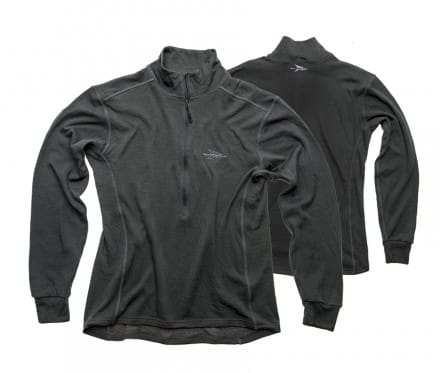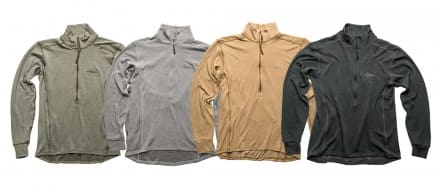The FirstSpear ACM Mid 400 material is a dual layer wool combination that works to pull moisture away from the base layer to help keep you cool or trap warmth when its cold. This material makes for an exceptionally high performance garment that can be worn all on its own or as another layering component. The mid shirt features a 2/3 front zip for extra comfort when layering or a quick vent when you get hot. A high collar will keep your neck protected and comfortable when running a sling.
Constructed from ACM MID 400: Dual layer 100? USA Wool Exterior, 100? Polyester Interior.
Now available in all new Charcoal, Sand, Commando, and Manatee Grey. Made in the USA with USA Materials.
Tags: FirstSpear





Why put the wool layer on the outer side? Wouldn’t you want the wool against the skin?
I had the same question when they released the ACM line and got this response from their apparel director.
“So as for our FS400 Mid weight material: We chose a 2 layer system, this is not a wool blend—rather 2 separate layers slightly knitted together. 100% Polyester material which is on the inside, against skin, and 100% Merino Wool layer on the outside.
The benefits of this approach:
-As I’m sure you know, wool is a great insulator even when wet- however it does not dry as fast as a synthetic. But when a synthetic is wet, you do not get those same warming insulative properties as you do with wool. So for FS400, when the wearer in a cold climate gets wet or begins to sweat, that inner polyester layer is going to quickly wick away any moisture from the skin, up to the wool layer. That moisture then absorbs and permeates into the wool- so you have this effect that makes for rapid moisture wicking away from skin (which causes discomfort), quicker rate of dry time with the poly layer, yet that wool layer is still going to keep you insulated while drying (no hypothermia issues like synthetics!).
-In the case of warmer wear, when sweat occurs that moisture is wicked away from the skin and again, transfers up to the wool layer—Wool is a natural anti-microbiant, so you won’t get the sweat smell you typically find with just synthetic base layers. Synthetics allow for the growth of bacteria which produces odor. We are pulling that sweat away from the skin very quickly, then up into the wool to dry, so there is not time for the poly to produce the bacteria that causes the odor. The bacteria that cases the stink is naturally unable to grow in merino wool. We wanted a merino wool material that is not only suited to cold conditions, but also for mild to warm climates as well. So having that poly against the skin in these warmer conditions, the synthetic will breath extremely well and keep you cooler even in humid environments.”
TLDR:
They took the best features of merino wool and wicking polyester and first spear’d the Sh*t out of them.
Well played, John. Had I been drinking anything when I read this, it would have flown out my nose…
Thats the best explaination Ive ever read for this type of hybrid garment
John, thanks for sharing that info. I can understand their reasoning but have two points of contention – comfort and durability.
I find the wool base layers to be more comfortable against the skin. With synthetic material I can only wear it so long before I want to kill to get it off me.
I do find the synthetic material to be more durable than wool as it is typically thicker.
Again, I understand their reasoning, but I just question if their line would be the right choice for me.
Turn it inside out?
Turn it back in… Why not just merino? As a base layer, whether it’s hot & humid or cold and dry, I think the consensus seems to be that Merino’s better. At least, that’s 1 opinion, and it’s seeming to be an echo of what’s going on here…
It could be because I’m Scottish but my Merino base layers stay packed at least 9 months of the year.
I think the idea of the ACM was to create a system that could offer superior performance year round.
I’m intrigued by this configuration.